Company and Industry Analysis for the Sydney Morning Herald
VerifiedAdded on 2023/02/01
|15
|2315
|89
AI Summary
This document provides a comprehensive analysis of the Sydney Morning Herald, including its company profile, market analysis, target market, competition, and SWOT analysis. It also discusses the newspaper industry and advertising trends.
Contribute Materials
Your contribution can guide someone’s learning journey. Share your
documents today.
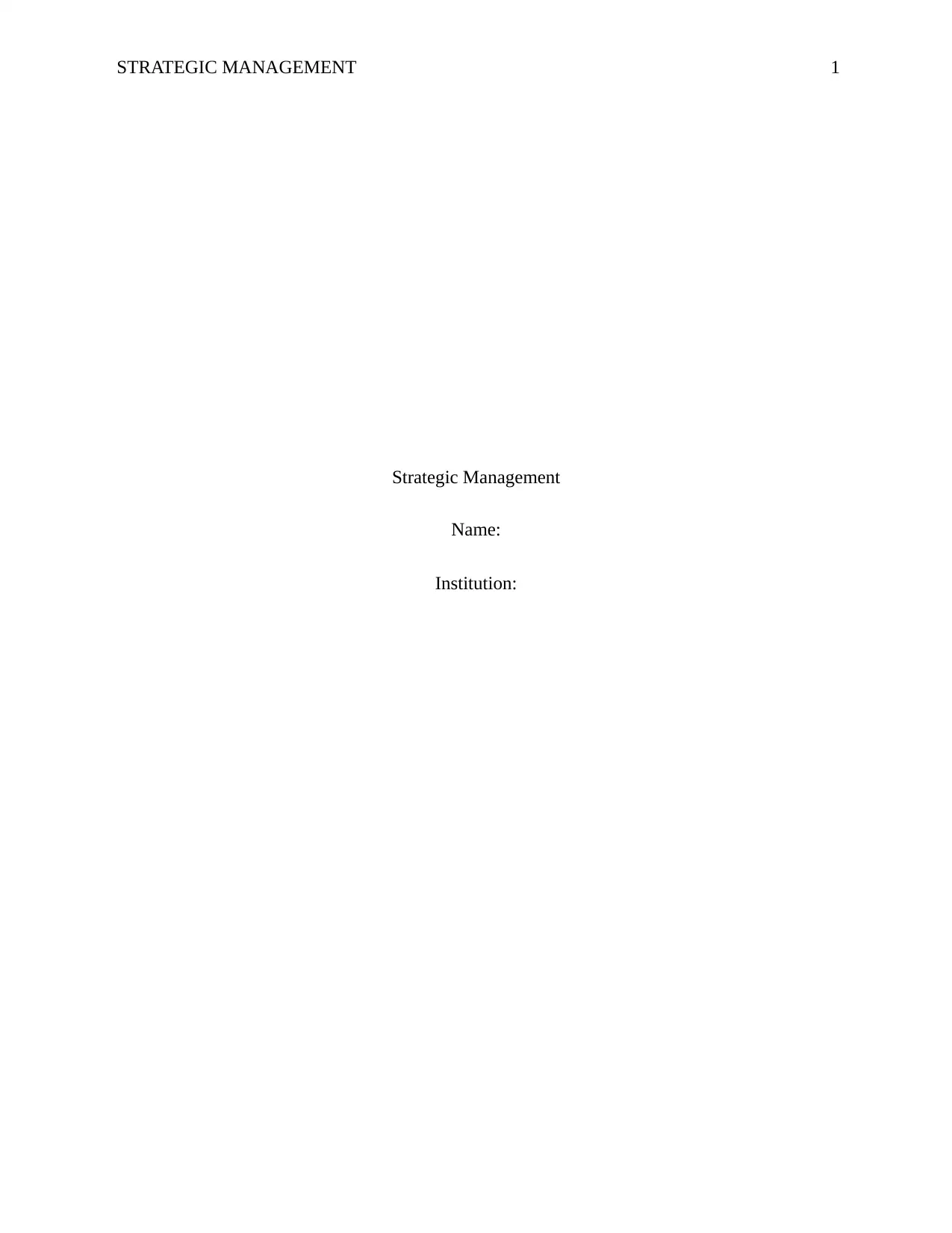
STRATEGIC MANAGEMENT 1
Strategic Management
Name:
Institution:
Strategic Management
Name:
Institution:
Secure Best Marks with AI Grader
Need help grading? Try our AI Grader for instant feedback on your assignments.

STRATEGIC MANAGEMENT 2
Company and Industry Analysis for the Sydney Morning Herald
1.0 Company Analysis of the Sydney Morning Herald
The Sydney Morning Herald is among the newspapers in Australia, having been founded in 1831.
Apparently, it is available both in electronic and paper format; with the paper format being published
six times a week. In 2013, the Audit Bureau of Circulation’s report on newspaper sales captured the
sales of the newspaper for Monday to Friday as being over 130,000 copies and over 220,000 on
Saturday. The print version is usually produced with at least one supplement per day, adding immense
value to the newspaper. Editorially, the newspaper considers itself as being generally “centrist” as is
cited in its editorial on 2004 where it stated: "market libertarianism and social liberalism" constituted
the "broad themes" that informed the paper. The newspaper has an ultramodern office with committed
staff under the Chief Editor, Lisa Davis.
The company has been keen to keep up with the signs of the time and for this reason was one of
the first newspaper companies to have a digital version that has a national reach in Australia. The
Herald has also strived to continuously upgrade its human resource base on pertinent issues regarding
current market trends and therefore the need to continue being market leaders. The company has over
the years additionally also invested in modern production equipment to ensure high quality production.
With all these factors in place, the company has continued to lag behind the Daily Telegraph, a
local rival newspaper, therefore the onus is upon the company to find means of gaining market
leadership. This is the main motivation by the company to produce and implement this business plan:
to enable the Sydney Morning Herald to gain leadership in the market.
Company and Industry Analysis for the Sydney Morning Herald
1.0 Company Analysis of the Sydney Morning Herald
The Sydney Morning Herald is among the newspapers in Australia, having been founded in 1831.
Apparently, it is available both in electronic and paper format; with the paper format being published
six times a week. In 2013, the Audit Bureau of Circulation’s report on newspaper sales captured the
sales of the newspaper for Monday to Friday as being over 130,000 copies and over 220,000 on
Saturday. The print version is usually produced with at least one supplement per day, adding immense
value to the newspaper. Editorially, the newspaper considers itself as being generally “centrist” as is
cited in its editorial on 2004 where it stated: "market libertarianism and social liberalism" constituted
the "broad themes" that informed the paper. The newspaper has an ultramodern office with committed
staff under the Chief Editor, Lisa Davis.
The company has been keen to keep up with the signs of the time and for this reason was one of
the first newspaper companies to have a digital version that has a national reach in Australia. The
Herald has also strived to continuously upgrade its human resource base on pertinent issues regarding
current market trends and therefore the need to continue being market leaders. The company has over
the years additionally also invested in modern production equipment to ensure high quality production.
With all these factors in place, the company has continued to lag behind the Daily Telegraph, a
local rival newspaper, therefore the onus is upon the company to find means of gaining market
leadership. This is the main motivation by the company to produce and implement this business plan:
to enable the Sydney Morning Herald to gain leadership in the market.
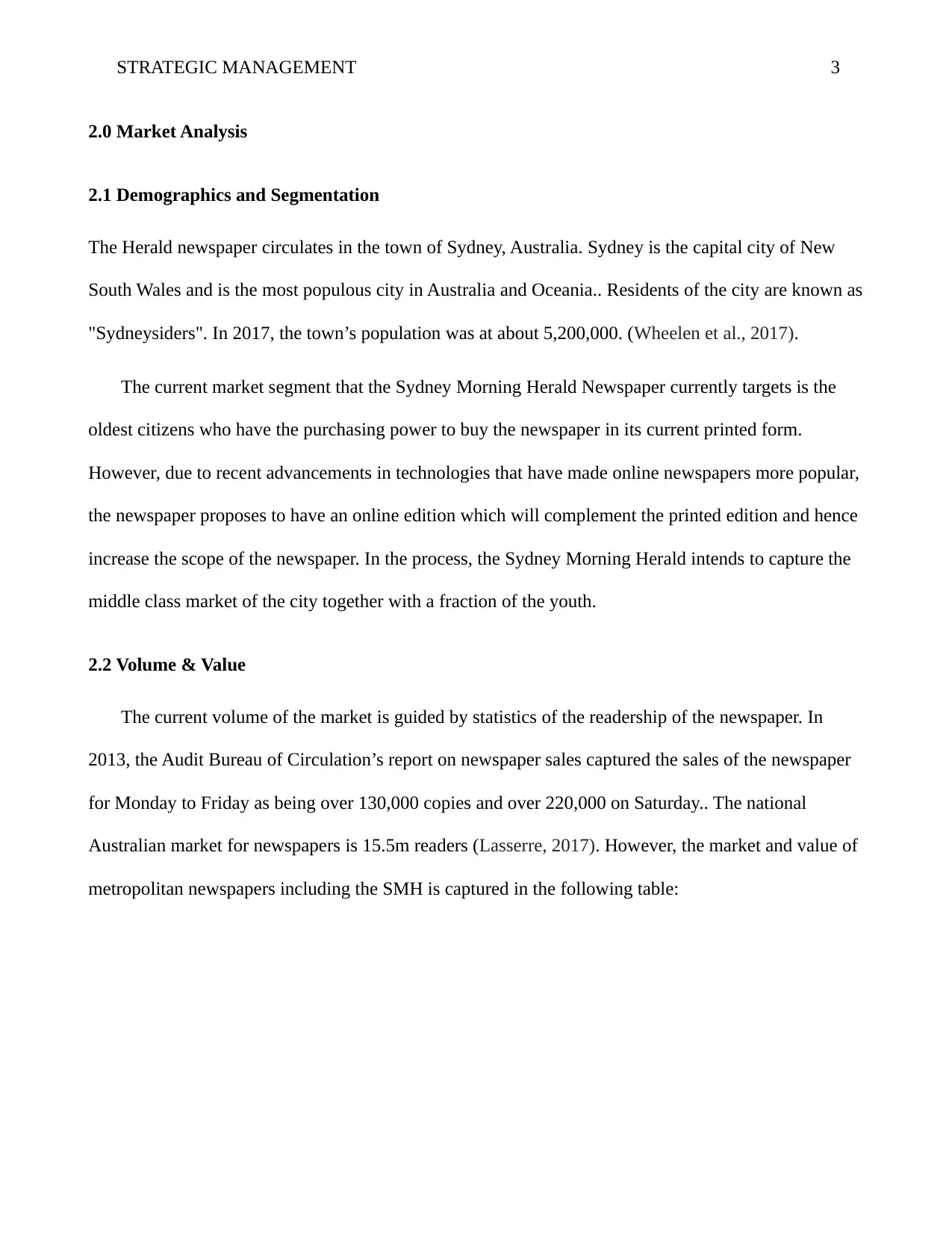
STRATEGIC MANAGEMENT 3
2.0 Market Analysis
2.1 Demographics and Segmentation
The Herald newspaper circulates in the town of Sydney, Australia. Sydney is the capital city of New
South Wales and is the most populous city in Australia and Oceania.. Residents of the city are known as
"Sydneysiders". In 2017, the town’s population was at about 5,200,000. (Wheelen et al., 2017).
The current market segment that the Sydney Morning Herald Newspaper currently targets is the
oldest citizens who have the purchasing power to buy the newspaper in its current printed form.
However, due to recent advancements in technologies that have made online newspapers more popular,
the newspaper proposes to have an online edition which will complement the printed edition and hence
increase the scope of the newspaper. In the process, the Sydney Morning Herald intends to capture the
middle class market of the city together with a fraction of the youth.
2.2 Volume & Value
The current volume of the market is guided by statistics of the readership of the newspaper. In
2013, the Audit Bureau of Circulation’s report on newspaper sales captured the sales of the newspaper
for Monday to Friday as being over 130,000 copies and over 220,000 on Saturday.. The national
Australian market for newspapers is 15.5m readers (Lasserre, 2017). However, the market and value of
metropolitan newspapers including the SMH is captured in the following table:
2.0 Market Analysis
2.1 Demographics and Segmentation
The Herald newspaper circulates in the town of Sydney, Australia. Sydney is the capital city of New
South Wales and is the most populous city in Australia and Oceania.. Residents of the city are known as
"Sydneysiders". In 2017, the town’s population was at about 5,200,000. (Wheelen et al., 2017).
The current market segment that the Sydney Morning Herald Newspaper currently targets is the
oldest citizens who have the purchasing power to buy the newspaper in its current printed form.
However, due to recent advancements in technologies that have made online newspapers more popular,
the newspaper proposes to have an online edition which will complement the printed edition and hence
increase the scope of the newspaper. In the process, the Sydney Morning Herald intends to capture the
middle class market of the city together with a fraction of the youth.
2.2 Volume & Value
The current volume of the market is guided by statistics of the readership of the newspaper. In
2013, the Audit Bureau of Circulation’s report on newspaper sales captured the sales of the newspaper
for Monday to Friday as being over 130,000 copies and over 220,000 on Saturday.. The national
Australian market for newspapers is 15.5m readers (Lasserre, 2017). However, the market and value of
metropolitan newspapers including the SMH is captured in the following table:
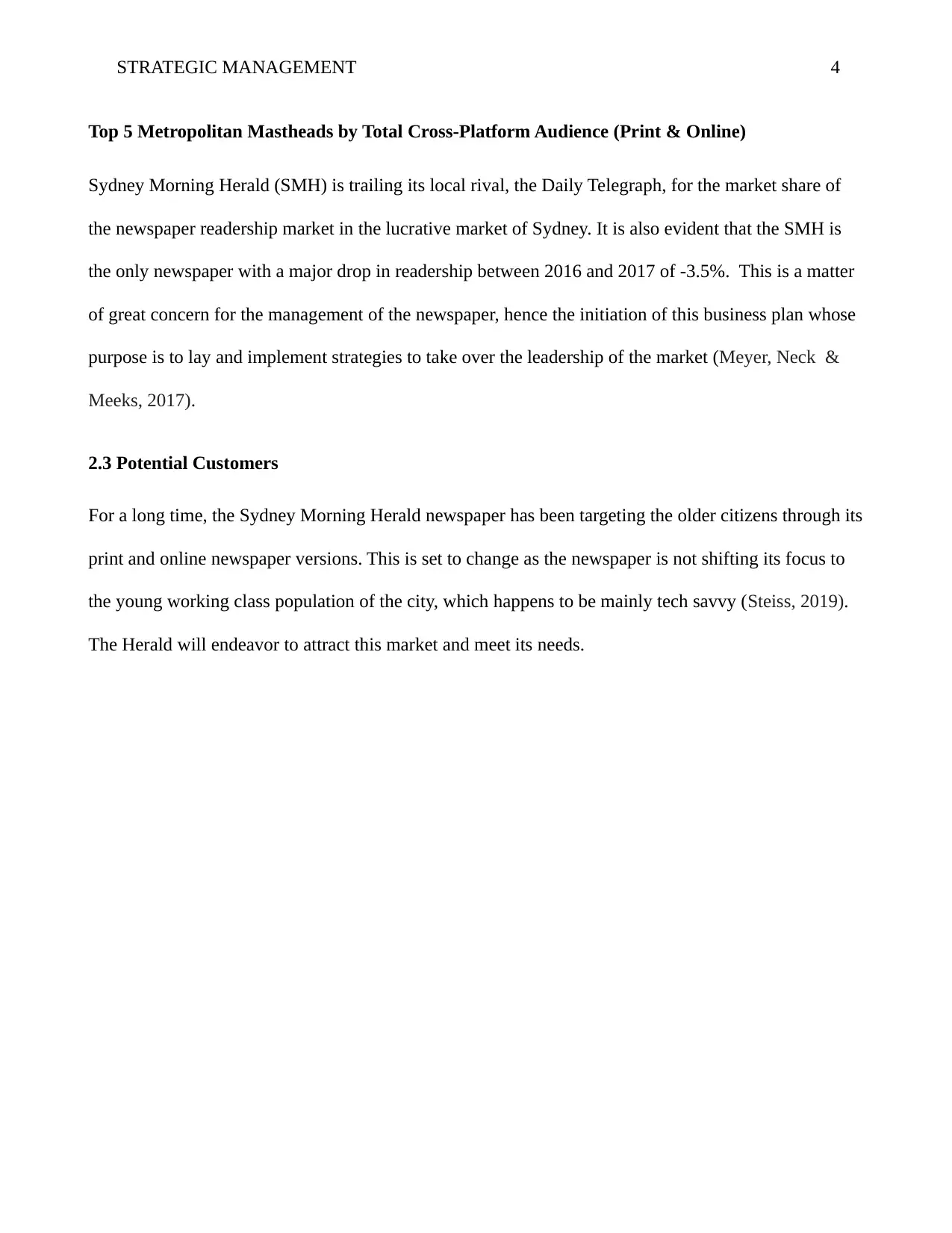
STRATEGIC MANAGEMENT 4
Top 5 Metropolitan Mastheads by Total Cross-Platform Audience (Print & Online)
Sydney Morning Herald (SMH) is trailing its local rival, the Daily Telegraph, for the market share of
the newspaper readership market in the lucrative market of Sydney. It is also evident that the SMH is
the only newspaper with a major drop in readership between 2016 and 2017 of -3.5%. This is a matter
of great concern for the management of the newspaper, hence the initiation of this business plan whose
purpose is to lay and implement strategies to take over the leadership of the market (Meyer, Neck &
Meeks, 2017).
2.3 Potential Customers
For a long time, the Sydney Morning Herald newspaper has been targeting the older citizens through its
print and online newspaper versions. This is set to change as the newspaper is not shifting its focus to
the young working class population of the city, which happens to be mainly tech savvy (Steiss, 2019).
The Herald will endeavor to attract this market and meet its needs.
Top 5 Metropolitan Mastheads by Total Cross-Platform Audience (Print & Online)
Sydney Morning Herald (SMH) is trailing its local rival, the Daily Telegraph, for the market share of
the newspaper readership market in the lucrative market of Sydney. It is also evident that the SMH is
the only newspaper with a major drop in readership between 2016 and 2017 of -3.5%. This is a matter
of great concern for the management of the newspaper, hence the initiation of this business plan whose
purpose is to lay and implement strategies to take over the leadership of the market (Meyer, Neck &
Meeks, 2017).
2.3 Potential Customers
For a long time, the Sydney Morning Herald newspaper has been targeting the older citizens through its
print and online newspaper versions. This is set to change as the newspaper is not shifting its focus to
the young working class population of the city, which happens to be mainly tech savvy (Steiss, 2019).
The Herald will endeavor to attract this market and meet its needs.
Paraphrase This Document
Need a fresh take? Get an instant paraphrase of this document with our AI Paraphraser
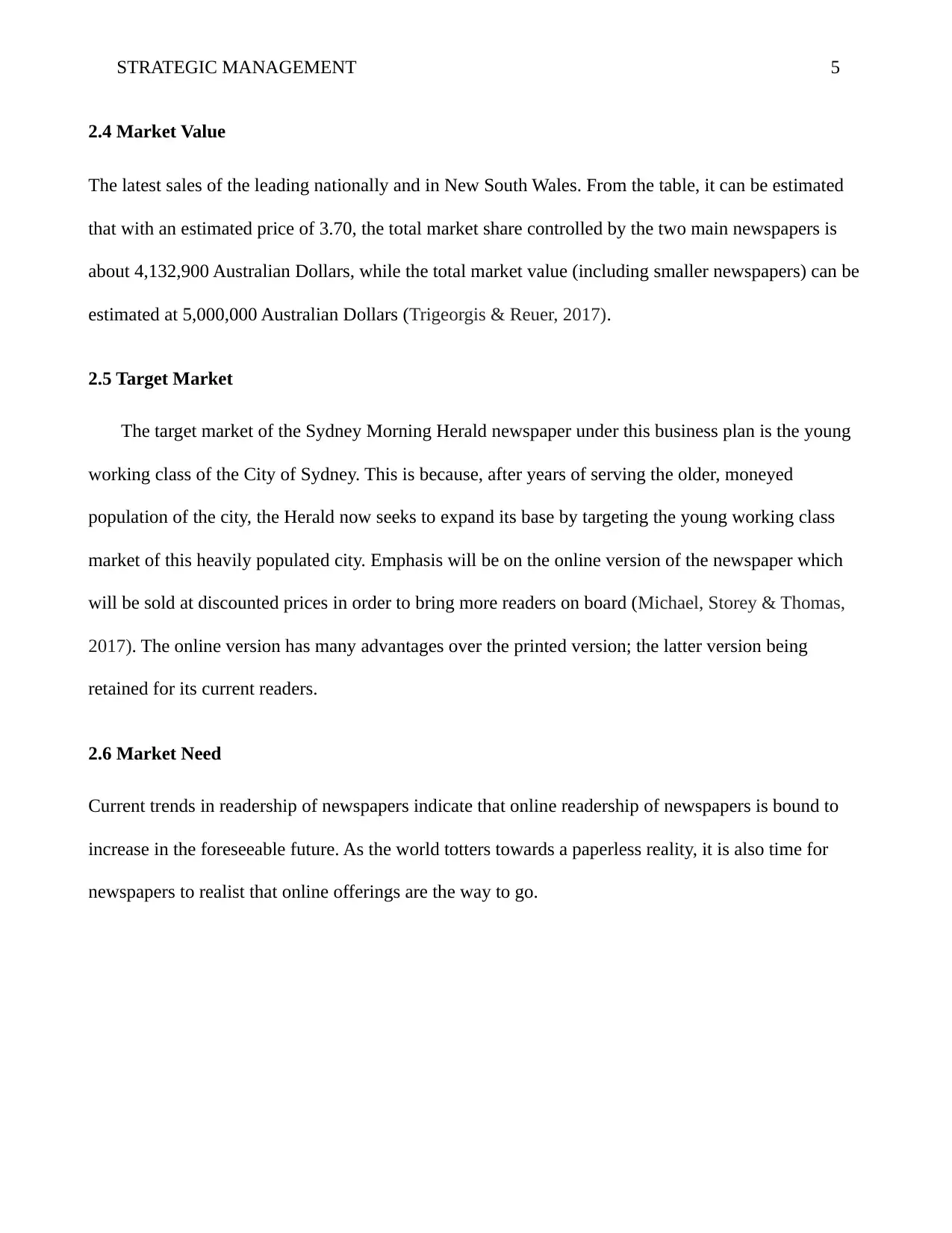
STRATEGIC MANAGEMENT 5
2.4 Market Value
The latest sales of the leading nationally and in New South Wales. From the table, it can be estimated
that with an estimated price of 3.70, the total market share controlled by the two main newspapers is
about 4,132,900 Australian Dollars, while the total market value (including smaller newspapers) can be
estimated at 5,000,000 Australian Dollars (Trigeorgis & Reuer, 2017).
2.5 Target Market
The target market of the Sydney Morning Herald newspaper under this business plan is the young
working class of the City of Sydney. This is because, after years of serving the older, moneyed
population of the city, the Herald now seeks to expand its base by targeting the young working class
market of this heavily populated city. Emphasis will be on the online version of the newspaper which
will be sold at discounted prices in order to bring more readers on board (Michael, Storey & Thomas,
2017). The online version has many advantages over the printed version; the latter version being
retained for its current readers.
2.6 Market Need
Current trends in readership of newspapers indicate that online readership of newspapers is bound to
increase in the foreseeable future. As the world totters towards a paperless reality, it is also time for
newspapers to realist that online offerings are the way to go.
2.4 Market Value
The latest sales of the leading nationally and in New South Wales. From the table, it can be estimated
that with an estimated price of 3.70, the total market share controlled by the two main newspapers is
about 4,132,900 Australian Dollars, while the total market value (including smaller newspapers) can be
estimated at 5,000,000 Australian Dollars (Trigeorgis & Reuer, 2017).
2.5 Target Market
The target market of the Sydney Morning Herald newspaper under this business plan is the young
working class of the City of Sydney. This is because, after years of serving the older, moneyed
population of the city, the Herald now seeks to expand its base by targeting the young working class
market of this heavily populated city. Emphasis will be on the online version of the newspaper which
will be sold at discounted prices in order to bring more readers on board (Michael, Storey & Thomas,
2017). The online version has many advantages over the printed version; the latter version being
retained for its current readers.
2.6 Market Need
Current trends in readership of newspapers indicate that online readership of newspapers is bound to
increase in the foreseeable future. As the world totters towards a paperless reality, it is also time for
newspapers to realist that online offerings are the way to go.

STRATEGIC MANAGEMENT 6
The above diagram shows that average circulation of metropolitan / national dailies has been steadily
falling from 2002 to 2012, and this is a reality that this business plan is alive to the world becoming
increasingly technological; it is becoming more fashionable for people seek all their information needs
from their gadgets; particularly smartphones, tablets and laptops (Lasserre, 2017). . There is therefore
need for the Sydney Morning Herald to aggressively provide information online to the convenience and
pleasure of its clientele.
Sydney Morning Herald has the competitive edge to deliver effectively as is evident above,
whereby our sales surpassed those of the Daily Telegraph our main rival for the first time in many years
in December 2018. We have been employing fresh graduates from our media schools and retraining the
older staff to be in sync with the times. Additionally, we have been continuously reviewing and
upgrading our technology and production techniques to ensure that they are equivalent to the industry’s
state of the art and this helps give the company an edge over the competition (Hitt & Duane, 2017).
The above diagram shows that average circulation of metropolitan / national dailies has been steadily
falling from 2002 to 2012, and this is a reality that this business plan is alive to the world becoming
increasingly technological; it is becoming more fashionable for people seek all their information needs
from their gadgets; particularly smartphones, tablets and laptops (Lasserre, 2017). . There is therefore
need for the Sydney Morning Herald to aggressively provide information online to the convenience and
pleasure of its clientele.
Sydney Morning Herald has the competitive edge to deliver effectively as is evident above,
whereby our sales surpassed those of the Daily Telegraph our main rival for the first time in many years
in December 2018. We have been employing fresh graduates from our media schools and retraining the
older staff to be in sync with the times. Additionally, we have been continuously reviewing and
upgrading our technology and production techniques to ensure that they are equivalent to the industry’s
state of the art and this helps give the company an edge over the competition (Hitt & Duane, 2017).
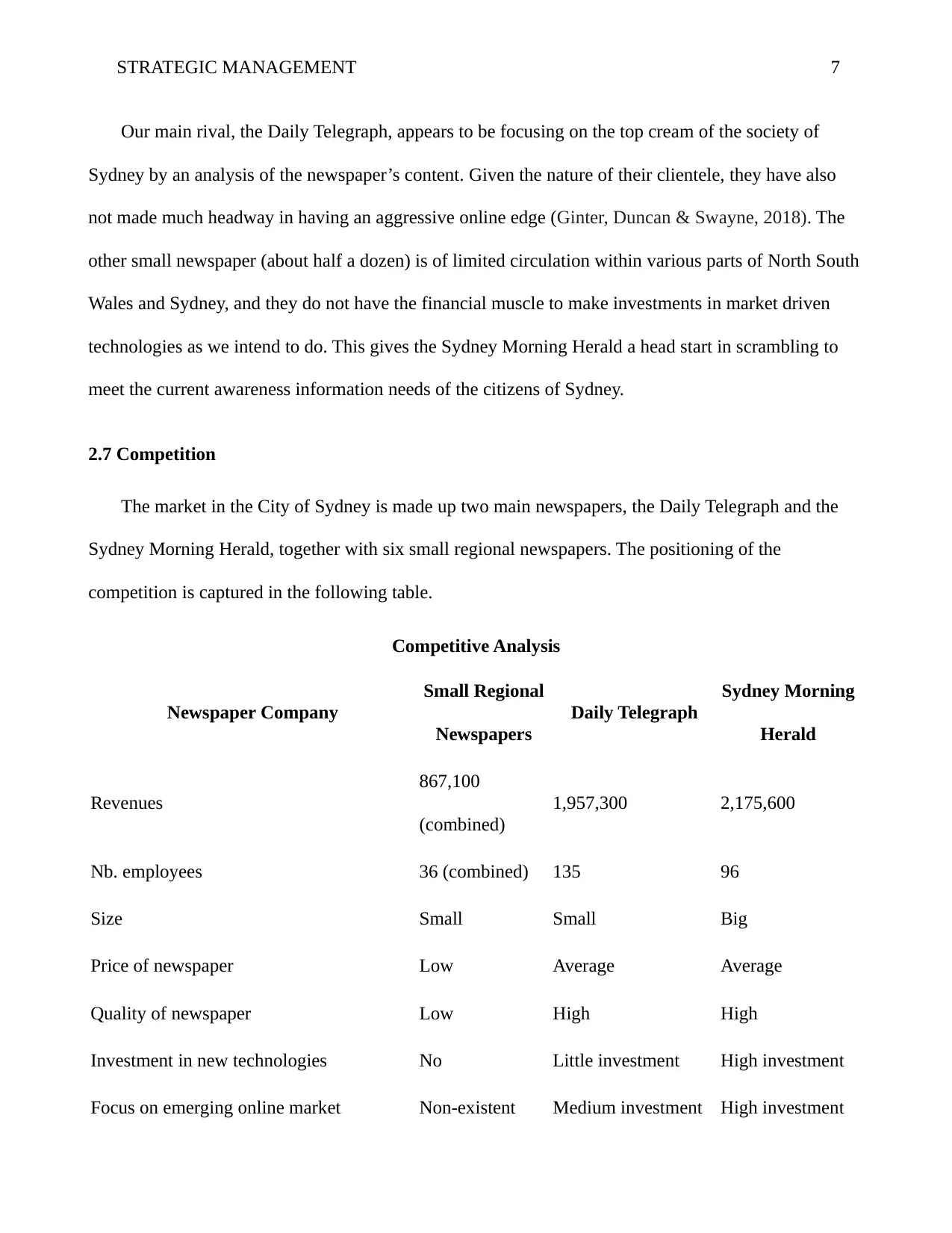
STRATEGIC MANAGEMENT 7
Our main rival, the Daily Telegraph, appears to be focusing on the top cream of the society of
Sydney by an analysis of the newspaper’s content. Given the nature of their clientele, they have also
not made much headway in having an aggressive online edge (Ginter, Duncan & Swayne, 2018). The
other small newspaper (about half a dozen) is of limited circulation within various parts of North South
Wales and Sydney, and they do not have the financial muscle to make investments in market driven
technologies as we intend to do. This gives the Sydney Morning Herald a head start in scrambling to
meet the current awareness information needs of the citizens of Sydney.
2.7 Competition
The market in the City of Sydney is made up two main newspapers, the Daily Telegraph and the
Sydney Morning Herald, together with six small regional newspapers. The positioning of the
competition is captured in the following table.
Competitive Analysis
Newspaper Company
Small Regional
Newspapers
Daily Telegraph
Sydney Morning
Herald
Revenues
867,100
(combined)
1,957,300 2,175,600
Nb. employees 36 (combined) 135 96
Size Small Small Big
Price of newspaper Low Average Average
Quality of newspaper Low High High
Investment in new technologies No Little investment High investment
Focus on emerging online market Non-existent Medium investment High investment
Our main rival, the Daily Telegraph, appears to be focusing on the top cream of the society of
Sydney by an analysis of the newspaper’s content. Given the nature of their clientele, they have also
not made much headway in having an aggressive online edge (Ginter, Duncan & Swayne, 2018). The
other small newspaper (about half a dozen) is of limited circulation within various parts of North South
Wales and Sydney, and they do not have the financial muscle to make investments in market driven
technologies as we intend to do. This gives the Sydney Morning Herald a head start in scrambling to
meet the current awareness information needs of the citizens of Sydney.
2.7 Competition
The market in the City of Sydney is made up two main newspapers, the Daily Telegraph and the
Sydney Morning Herald, together with six small regional newspapers. The positioning of the
competition is captured in the following table.
Competitive Analysis
Newspaper Company
Small Regional
Newspapers
Daily Telegraph
Sydney Morning
Herald
Revenues
867,100
(combined)
1,957,300 2,175,600
Nb. employees 36 (combined) 135 96
Size Small Small Big
Price of newspaper Low Average Average
Quality of newspaper Low High High
Investment in new technologies No Little investment High investment
Focus on emerging online market Non-existent Medium investment High investment
Secure Best Marks with AI Grader
Need help grading? Try our AI Grader for instant feedback on your assignments.

STRATEGIC MANAGEMENT 8
Newspaper Company
Small Regional
Newspapers
Daily Telegraph
Sydney Morning
Herald
Market focus
Small niche
markets
Upper middle class
Upper middle
class and the rich
From the foregoing information, the strengths and weaknesses of our rivals are as follows:
Small Suburban Newspapers
Strengths: small overhead costs, small, loyal customer base
Weaknesses: little room for market growth, financial inability to expand operations, low quality
productions (Morschett, Schramm-Klein & Zentes, 2015).
Daily Telegraph
Strengths: Market leader, possession of financial muscle to acquire technology, improves processes,
deals with the rich upper segment of Sydney’s society which is financially lucrative (Morden, 2016).
Weaknesses: Inability to monitor emerging trends in changes in consumption and adopting to them,
inability to invest in staff training, aging editorial and field journalists (Ansoff et al., 2018).
The Sydney Morning Herald therefore will seek to capitalize on the weaknesses of its rivals in order to
rapidly gain leadership of the market. Some strengths, weaknesses, opportunities and threats of the
Sydney Morning Herald are captured in the following table:
Newspaper Company
Small Regional
Newspapers
Daily Telegraph
Sydney Morning
Herald
Market focus
Small niche
markets
Upper middle class
Upper middle
class and the rich
From the foregoing information, the strengths and weaknesses of our rivals are as follows:
Small Suburban Newspapers
Strengths: small overhead costs, small, loyal customer base
Weaknesses: little room for market growth, financial inability to expand operations, low quality
productions (Morschett, Schramm-Klein & Zentes, 2015).
Daily Telegraph
Strengths: Market leader, possession of financial muscle to acquire technology, improves processes,
deals with the rich upper segment of Sydney’s society which is financially lucrative (Morden, 2016).
Weaknesses: Inability to monitor emerging trends in changes in consumption and adopting to them,
inability to invest in staff training, aging editorial and field journalists (Ansoff et al., 2018).
The Sydney Morning Herald therefore will seek to capitalize on the weaknesses of its rivals in order to
rapidly gain leadership of the market. Some strengths, weaknesses, opportunities and threats of the
Sydney Morning Herald are captured in the following table:
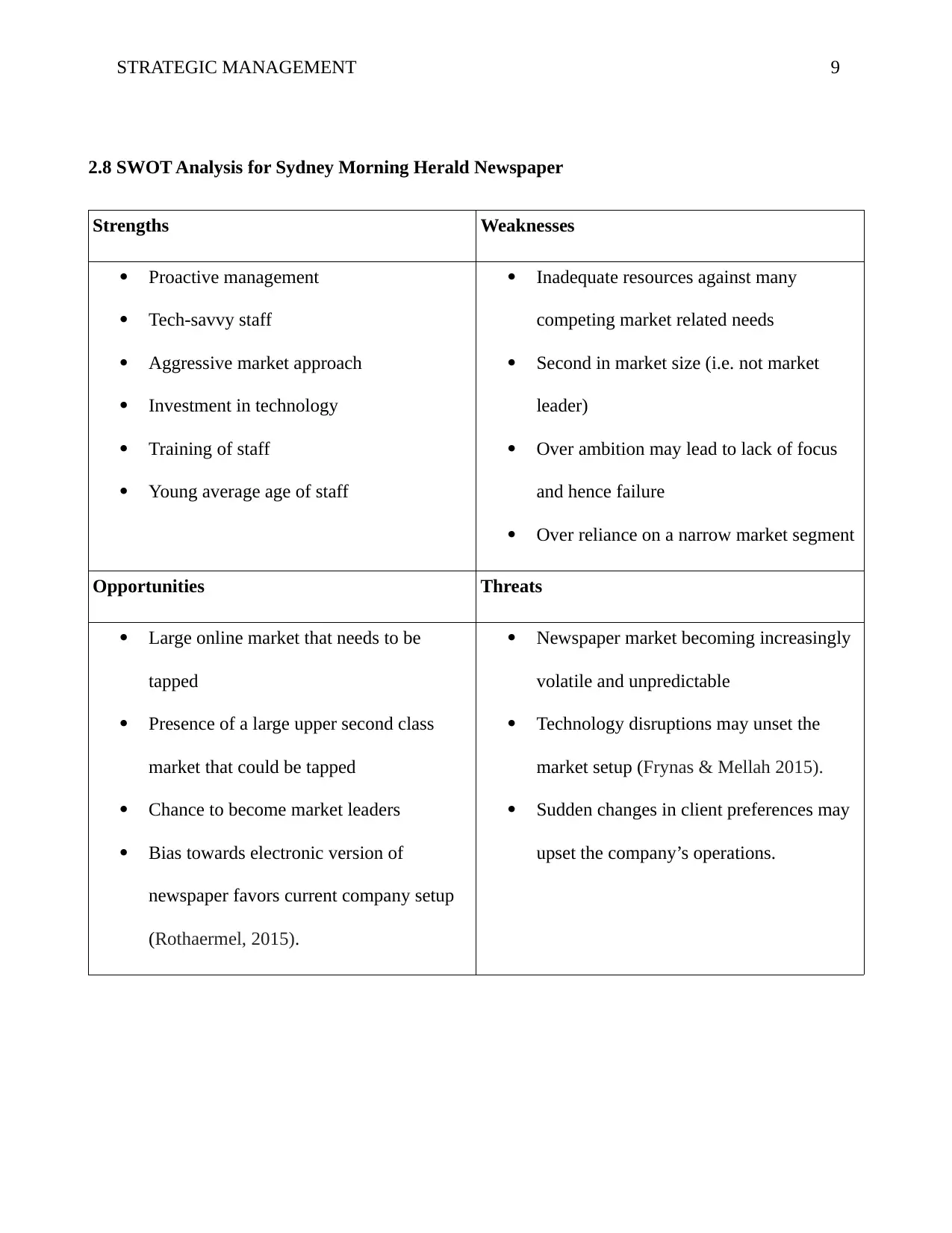
STRATEGIC MANAGEMENT 9
2.8 SWOT Analysis for Sydney Morning Herald Newspaper
Strengths Weaknesses
Proactive management
Tech-savvy staff
Aggressive market approach
Investment in technology
Training of staff
Young average age of staff
Inadequate resources against many
competing market related needs
Second in market size (i.e. not market
leader)
Over ambition may lead to lack of focus
and hence failure
Over reliance on a narrow market segment
Opportunities Threats
Large online market that needs to be
tapped
Presence of a large upper second class
market that could be tapped
Chance to become market leaders
Bias towards electronic version of
newspaper favors current company setup
(Rothaermel, 2015).
Newspaper market becoming increasingly
volatile and unpredictable
Technology disruptions may unset the
market setup (Frynas & Mellah 2015).
Sudden changes in client preferences may
upset the company’s operations.
2.8 SWOT Analysis for Sydney Morning Herald Newspaper
Strengths Weaknesses
Proactive management
Tech-savvy staff
Aggressive market approach
Investment in technology
Training of staff
Young average age of staff
Inadequate resources against many
competing market related needs
Second in market size (i.e. not market
leader)
Over ambition may lead to lack of focus
and hence failure
Over reliance on a narrow market segment
Opportunities Threats
Large online market that needs to be
tapped
Presence of a large upper second class
market that could be tapped
Chance to become market leaders
Bias towards electronic version of
newspaper favors current company setup
(Rothaermel, 2015).
Newspaper market becoming increasingly
volatile and unpredictable
Technology disruptions may unset the
market setup (Frynas & Mellah 2015).
Sudden changes in client preferences may
upset the company’s operations.
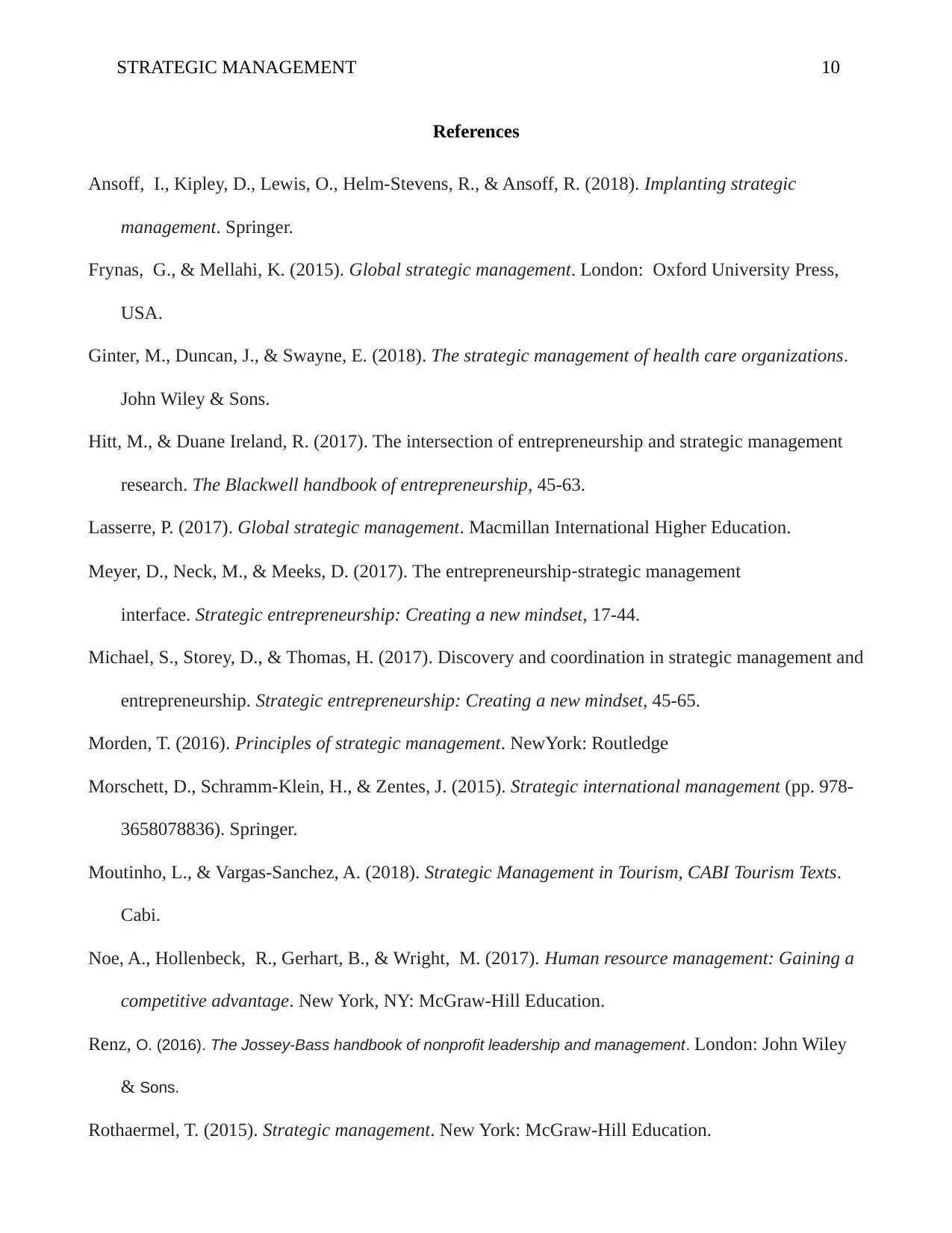
STRATEGIC MANAGEMENT 10
References
Ansoff, I., Kipley, D., Lewis, O., Helm-Stevens, R., & Ansoff, R. (2018). Implanting strategic
management. Springer.
Frynas, G., & Mellahi, K. (2015). Global strategic management. London: Oxford University Press,
USA.
Ginter, M., Duncan, J., & Swayne, E. (2018). The strategic management of health care organizations.
John Wiley & Sons.
Hitt, M., & Duane Ireland, R. (2017). The intersection of entrepreneurship and strategic management
research. The Blackwell handbook of entrepreneurship, 45-63.
Lasserre, P. (2017). Global strategic management. Macmillan International Higher Education.
Meyer, D., Neck, M., & Meeks, D. (2017). The entrepreneurship‐strategic management
interface. Strategic entrepreneurship: Creating a new mindset, 17-44.
Michael, S., Storey, D., & Thomas, H. (2017). Discovery and coordination in strategic management and
entrepreneurship. Strategic entrepreneurship: Creating a new mindset, 45-65.
Morden, T. (2016). Principles of strategic management. NewYork: Routledge
Morschett, D., Schramm-Klein, H., & Zentes, J. (2015). Strategic international management (pp. 978-
3658078836). Springer.
Moutinho, L., & Vargas-Sanchez, A. (2018). Strategic Management in Tourism, CABI Tourism Texts.
Cabi.
Noe, A., Hollenbeck, R., Gerhart, B., & Wright, M. (2017). Human resource management: Gaining a
competitive advantage. New York, NY: McGraw-Hill Education.
Renz, O. (2016). The Jossey-Bass handbook of nonprofit leadership and management. London: John Wiley
& Sons.
Rothaermel, T. (2015). Strategic management. New York: McGraw-Hill Education.
References
Ansoff, I., Kipley, D., Lewis, O., Helm-Stevens, R., & Ansoff, R. (2018). Implanting strategic
management. Springer.
Frynas, G., & Mellahi, K. (2015). Global strategic management. London: Oxford University Press,
USA.
Ginter, M., Duncan, J., & Swayne, E. (2018). The strategic management of health care organizations.
John Wiley & Sons.
Hitt, M., & Duane Ireland, R. (2017). The intersection of entrepreneurship and strategic management
research. The Blackwell handbook of entrepreneurship, 45-63.
Lasserre, P. (2017). Global strategic management. Macmillan International Higher Education.
Meyer, D., Neck, M., & Meeks, D. (2017). The entrepreneurship‐strategic management
interface. Strategic entrepreneurship: Creating a new mindset, 17-44.
Michael, S., Storey, D., & Thomas, H. (2017). Discovery and coordination in strategic management and
entrepreneurship. Strategic entrepreneurship: Creating a new mindset, 45-65.
Morden, T. (2016). Principles of strategic management. NewYork: Routledge
Morschett, D., Schramm-Klein, H., & Zentes, J. (2015). Strategic international management (pp. 978-
3658078836). Springer.
Moutinho, L., & Vargas-Sanchez, A. (2018). Strategic Management in Tourism, CABI Tourism Texts.
Cabi.
Noe, A., Hollenbeck, R., Gerhart, B., & Wright, M. (2017). Human resource management: Gaining a
competitive advantage. New York, NY: McGraw-Hill Education.
Renz, O. (2016). The Jossey-Bass handbook of nonprofit leadership and management. London: John Wiley
& Sons.
Rothaermel, T. (2015). Strategic management. New York: McGraw-Hill Education.
Paraphrase This Document
Need a fresh take? Get an instant paraphrase of this document with our AI Paraphraser
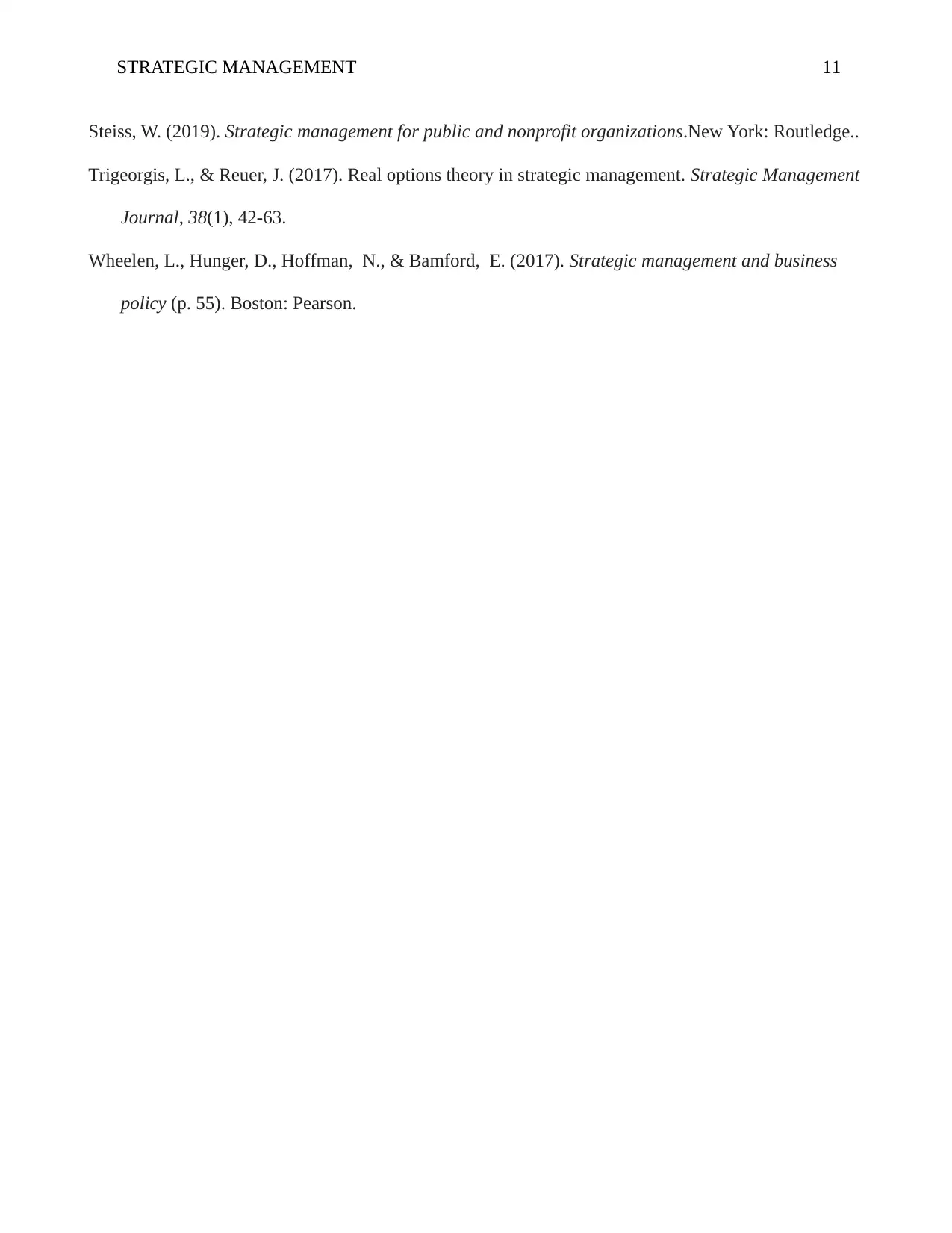
STRATEGIC MANAGEMENT 11
Steiss, W. (2019). Strategic management for public and nonprofit organizations.New York: Routledge..
Trigeorgis, L., & Reuer, J. (2017). Real options theory in strategic management. Strategic Management
Journal, 38(1), 42-63.
Wheelen, L., Hunger, D., Hoffman, N., & Bamford, E. (2017). Strategic management and business
policy (p. 55). Boston: Pearson.
Steiss, W. (2019). Strategic management for public and nonprofit organizations.New York: Routledge..
Trigeorgis, L., & Reuer, J. (2017). Real options theory in strategic management. Strategic Management
Journal, 38(1), 42-63.
Wheelen, L., Hunger, D., Hoffman, N., & Bamford, E. (2017). Strategic management and business
policy (p. 55). Boston: Pearson.
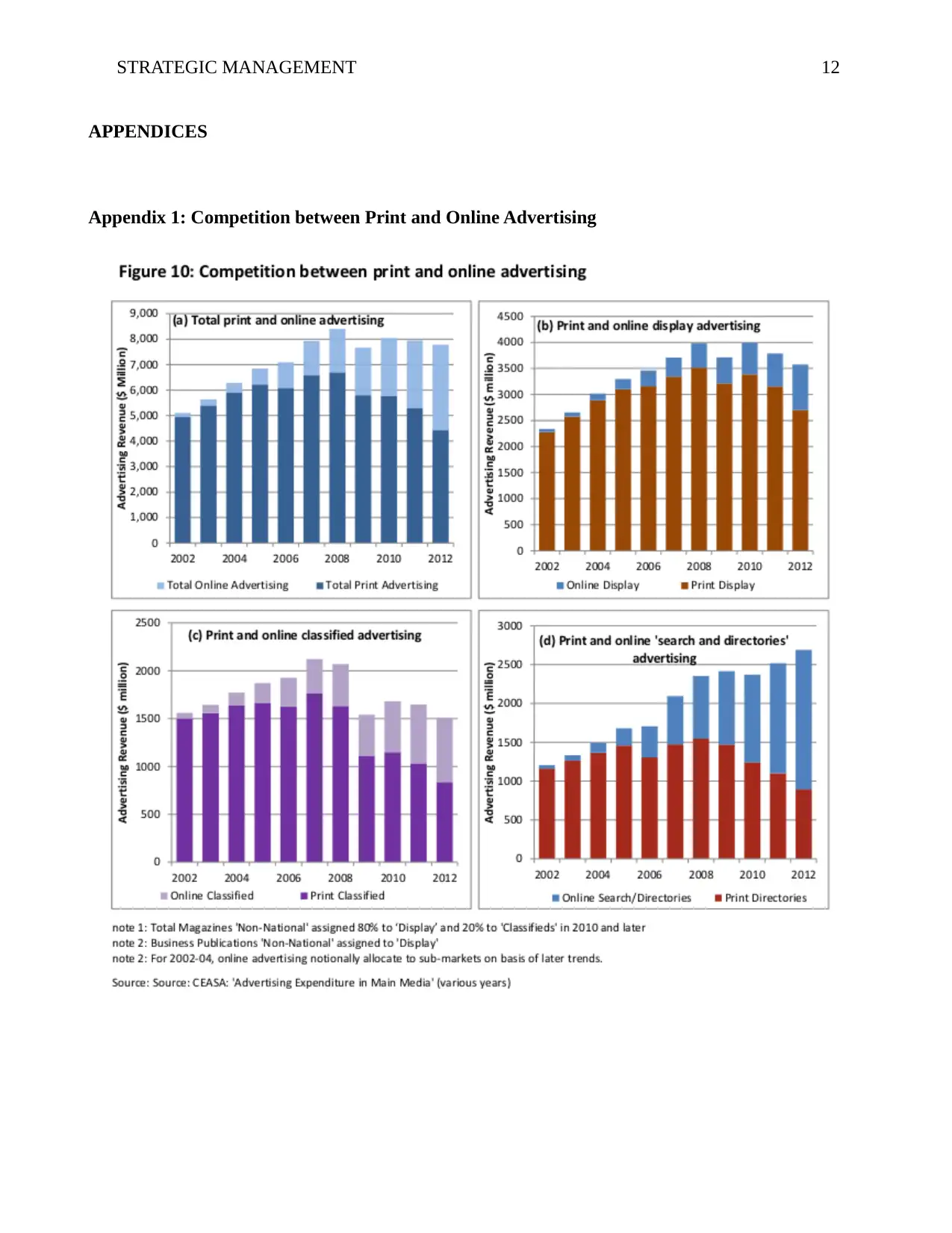
STRATEGIC MANAGEMENT 12
APPENDICES
Appendix 1: Competition between Print and Online Advertising
APPENDICES
Appendix 1: Competition between Print and Online Advertising
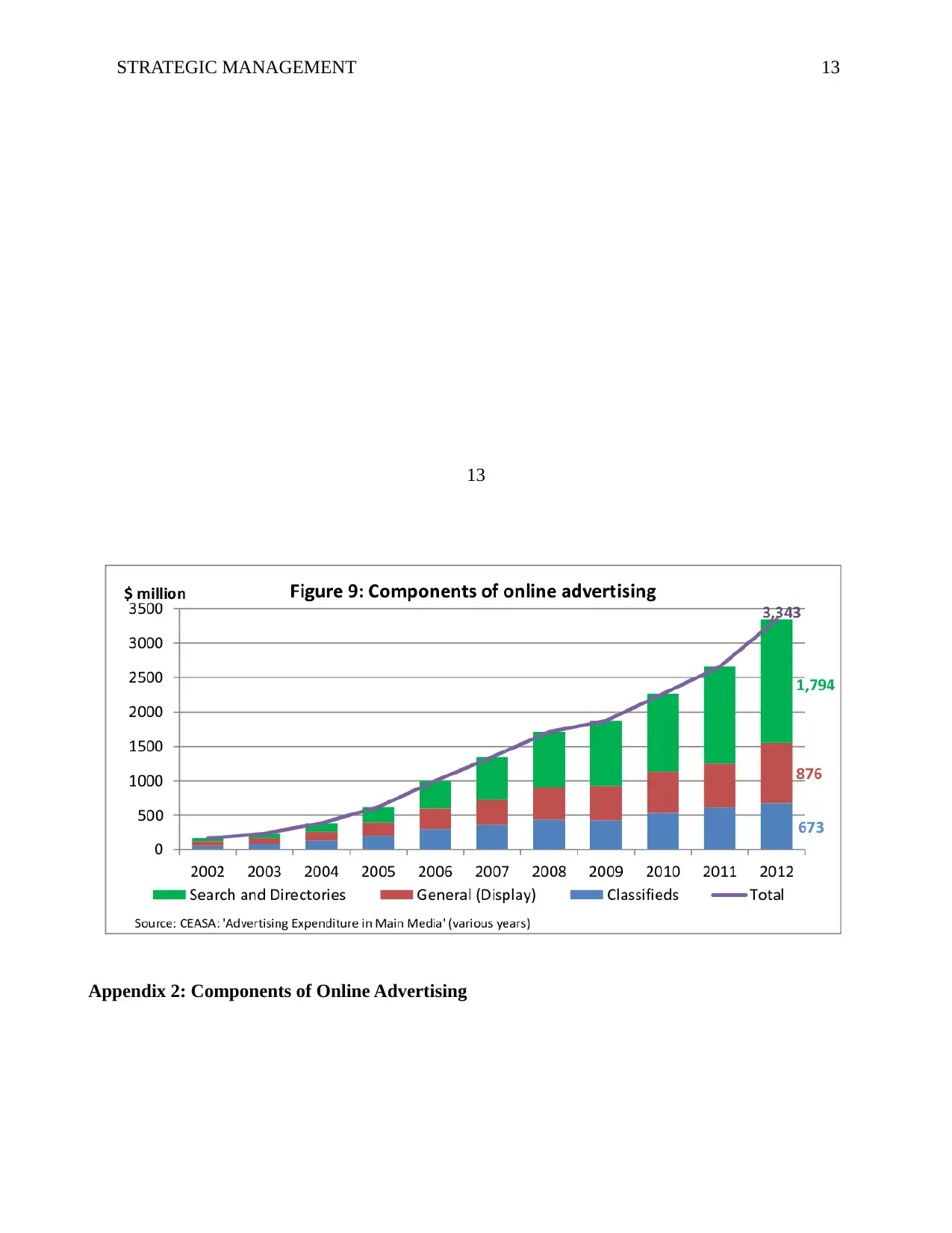
STRATEGIC MANAGEMENT 13
13
Appendix 2: Components of Online Advertising
13
Appendix 2: Components of Online Advertising
Secure Best Marks with AI Grader
Need help grading? Try our AI Grader for instant feedback on your assignments.
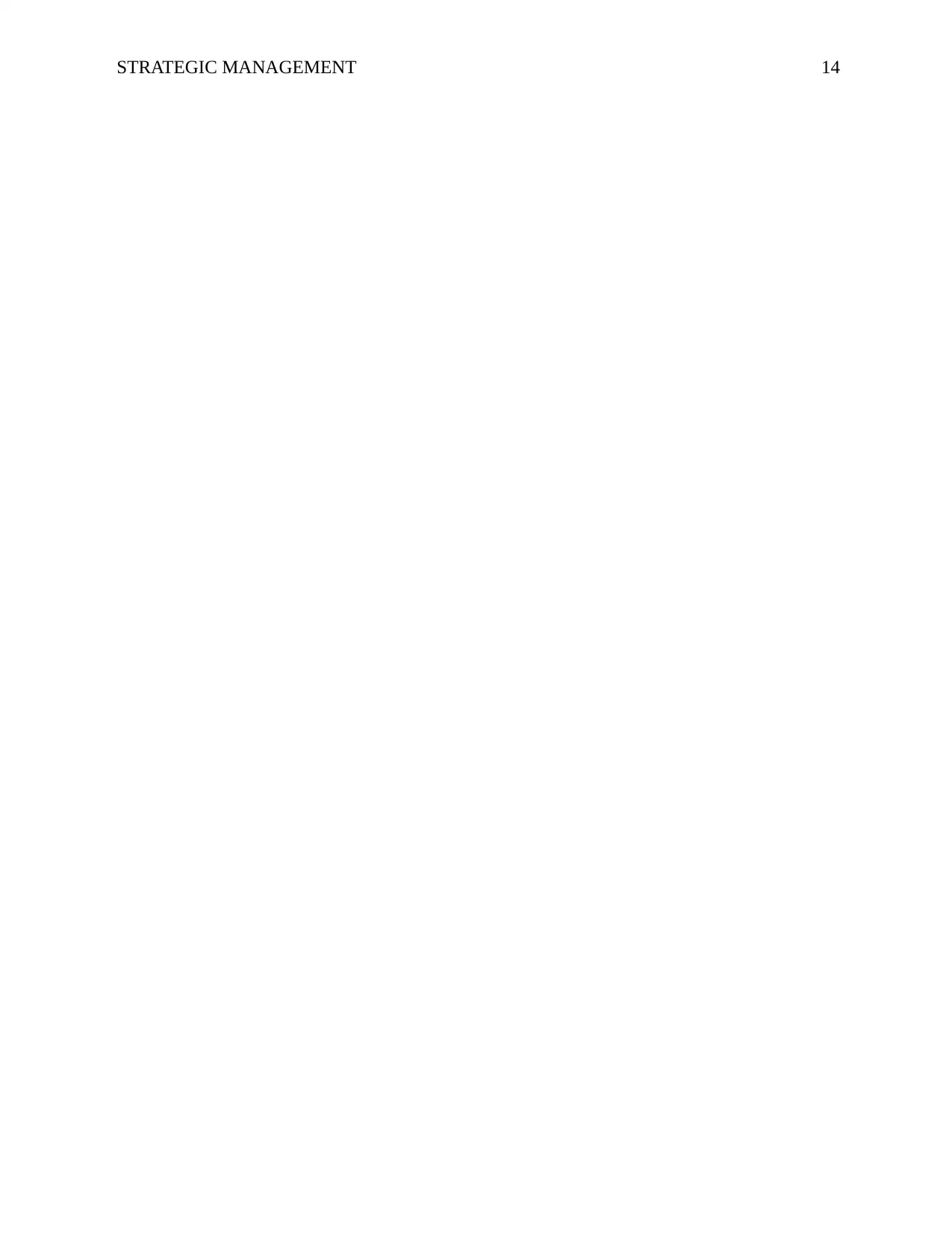
STRATEGIC MANAGEMENT 14
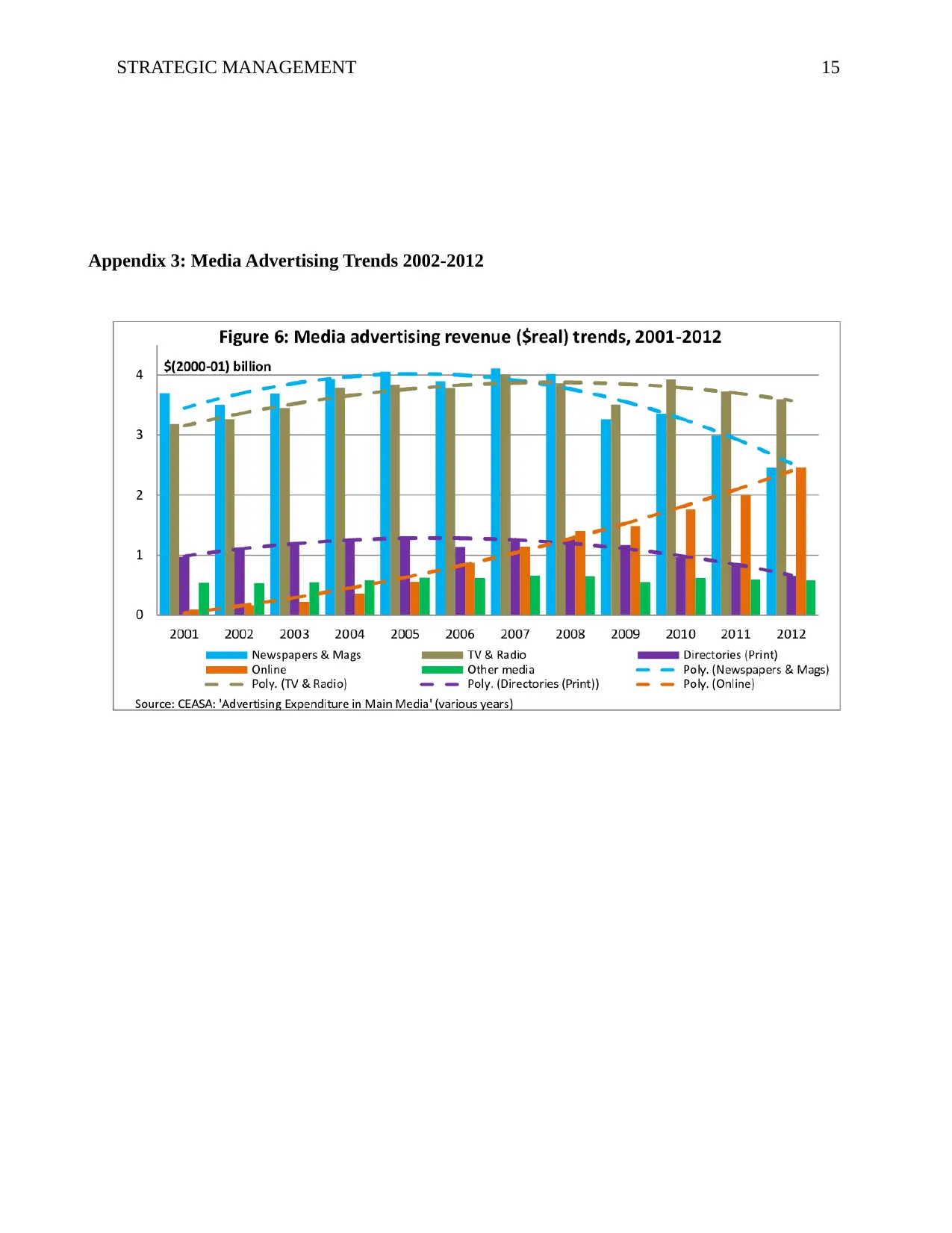
STRATEGIC MANAGEMENT 15
Appendix 3: Media Advertising Trends 2002-2012
Appendix 3: Media Advertising Trends 2002-2012
1 out of 15
![[object Object]](/_next/static/media/star-bottom.7253800d.svg)

